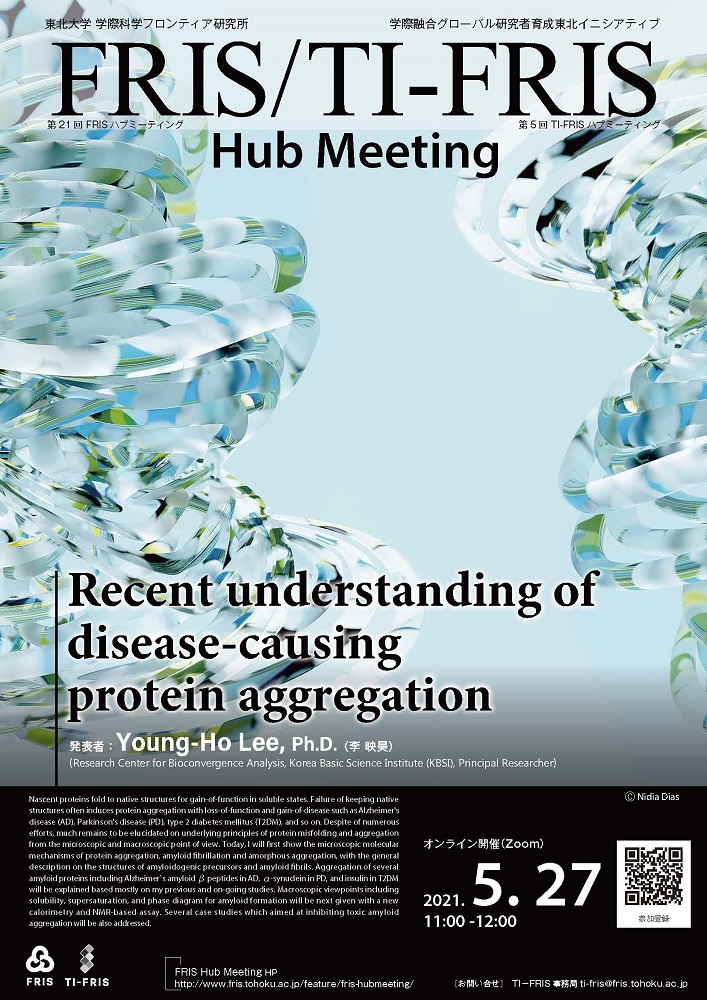May 7, 2021
第5回 TI-FRIS Hub Meeting/第21回 FRIS Hub Meeting(オンライン)
オンライン開催
TI-FRIS Hub Meetingは、専門分野と機関の垣根を越えた学際融合研究の重要性を理解し、活用することができる研究者を育成するために、東北大学で月1回開催しています。
TI-FRIS Hub Meetingは、専門分野と機関の垣根を越えた学際融合研究の重要性を理解し、活用することができる研究者を育成するために、東北大学で月1回開催しています。
言語は日本語と英語を混ぜて使用しています。異分野研究者同士では共通の常識や考え方は望めません。聴衆は発表中にどんどん質問し、討論し、理解を深めるようにしています。積極的にご参加ください。
第5回 TI-FRIS Hub Meeting(第21回 FRIS Hub Meetingとの合同開催)
第5回 TI-FRIS Hub Meeting(第21回 FRIS Hub Meetingとの合同開催)
日時:
2021年5月27日(木)11:00-12:00
開催方式:
オンライン(Zoom)
事前登録が必要になります。参加申し込みフォームよりご登録ください。
事前登録が必要になります。参加申し込みフォームよりご登録ください。
発表者:
Young-Ho LEE (李 映昊), Ph.D.(Research Center for Bioconvergence Analysis, Korea Basic Science Institute (KBSI), Principal Researcher)
発表タイトル:
Recent understanding of disease-causing protein aggregation
要旨:
Recent understanding of disease-causing protein aggregation
要旨:
Young-Ho Lee(李 映昊)1-4
1Research Center for Bioconvergence Analysis, Korea Basic Science Institute, Korea
2Bio-Analytical Science, Univ. of Science and Technology, Korea
3Research headquarters, Korea Brain Research Institute, Korea
4Graduate School of Analytical Science and Technology, Chungnam National Univ., Korea
Nascent proteins fold to native structures for gain-of-function in soluble states. Failure of keeping native structures often induces protein aggregation with loss-of-function and gain-of-disease such as Alzheimer's disease (AD), Parkinson's disease (PD), type 2 diabetes mellitus (T2DM), and so on.1-3 Despite of numerous efforts, much remains to be elucidated on underlying principles of protein misfolding and aggregation from the microscopic and macroscopic point of view. Today, I will first show the microscopic molecular mechanisms of protein aggregation, amyloid fibrillation and amorphous aggregation, with the general description on the structures of amyloidogenic precursors and amyloid fibrils.4-8 Aggregation of several amyloid proteins including Alzheimer`s amyloid b peptides in AD, a-synuclein in PD, and insulin in T2DM will be explained based mostly on my previous and on-going studies. Macroscopic viewpoints including solubility, supersaturation, and phase diagram for amyloid formation will be next given with a new calorimetry and NMR-based assay.3, 9-18 Several case studies which aimed at inhibiting toxic amyloid aggregation will be also addressed.19
References
[1] Lee et. al. Biochim. Biophys. Acta.- Proteins Proteom. (2019); [2] Terakawa et. al. Biochim. Biophys. Acta.-Biomembr. (2018); [3] Nam and Lin et. al. Chem (2020); [4] Terakawa and Lee et. al. Biochim. Biophys. Acta.-Biomembr. (2018); [5] Lee and Ramamoorthy Protein Sci. (2018); [6] Terakawa and Lee et. al. Biochim. Biophys. Acta.-Biomembr. (2018); [7] Micsonai et. al. Nucleic Acids Res. (2018); [8] Micsonai et. al. Proc. Natl. Acad. Sci. USA. (2015); [9] Kinoshita et. al. Phys. Chem. Chem. Phys. (2017); [10] Terakawa et. al. J. Biol. Chem. (2014); [11] Korshavn et. al. J. Biol. Chem. (2017); [12] Lin et. al. Langmuir (2016); [13] Ikenoue and Lee et. al. Angewandte chemie (2014); [14] Ikenoue and Lee et. al. Proc. Natl. Acad. Sci. USA. (2014); [15] Lin et. al. ACS Nano (2019); [16] Kinoshita and Lin et. al. ChemComm (2018); [17] Park et. al. Proc. Natl. Acad. Sci. USA. (2019); [18] Yi et. al. Chem. Sci. (2021); [19] Kim et. al. Nature Nanotechnol. (2018)
1Research Center for Bioconvergence Analysis, Korea Basic Science Institute, Korea
2Bio-Analytical Science, Univ. of Science and Technology, Korea
3Research headquarters, Korea Brain Research Institute, Korea
4Graduate School of Analytical Science and Technology, Chungnam National Univ., Korea
Nascent proteins fold to native structures for gain-of-function in soluble states. Failure of keeping native structures often induces protein aggregation with loss-of-function and gain-of-disease such as Alzheimer's disease (AD), Parkinson's disease (PD), type 2 diabetes mellitus (T2DM), and so on.1-3 Despite of numerous efforts, much remains to be elucidated on underlying principles of protein misfolding and aggregation from the microscopic and macroscopic point of view. Today, I will first show the microscopic molecular mechanisms of protein aggregation, amyloid fibrillation and amorphous aggregation, with the general description on the structures of amyloidogenic precursors and amyloid fibrils.4-8 Aggregation of several amyloid proteins including Alzheimer`s amyloid b peptides in AD, a-synuclein in PD, and insulin in T2DM will be explained based mostly on my previous and on-going studies. Macroscopic viewpoints including solubility, supersaturation, and phase diagram for amyloid formation will be next given with a new calorimetry and NMR-based assay.3, 9-18 Several case studies which aimed at inhibiting toxic amyloid aggregation will be also addressed.19
References
[1] Lee et. al. Biochim. Biophys. Acta.- Proteins Proteom. (2019); [2] Terakawa et. al. Biochim. Biophys. Acta.-Biomembr. (2018); [3] Nam and Lin et. al. Chem (2020); [4] Terakawa and Lee et. al. Biochim. Biophys. Acta.-Biomembr. (2018); [5] Lee and Ramamoorthy Protein Sci. (2018); [6] Terakawa and Lee et. al. Biochim. Biophys. Acta.-Biomembr. (2018); [7] Micsonai et. al. Nucleic Acids Res. (2018); [8] Micsonai et. al. Proc. Natl. Acad. Sci. USA. (2015); [9] Kinoshita et. al. Phys. Chem. Chem. Phys. (2017); [10] Terakawa et. al. J. Biol. Chem. (2014); [11] Korshavn et. al. J. Biol. Chem. (2017); [12] Lin et. al. Langmuir (2016); [13] Ikenoue and Lee et. al. Angewandte chemie (2014); [14] Ikenoue and Lee et. al. Proc. Natl. Acad. Sci. USA. (2014); [15] Lin et. al. ACS Nano (2019); [16] Kinoshita and Lin et. al. ChemComm (2018); [17] Park et. al. Proc. Natl. Acad. Sci. USA. (2019); [18] Yi et. al. Chem. Sci. (2021); [19] Kim et. al. Nature Nanotechnol. (2018)


